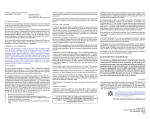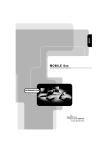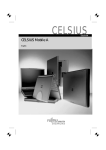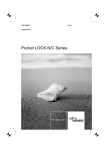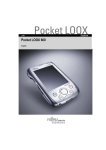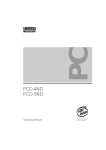Download Fujitsu AMILO Pro V1000 Notebook
Transcript
answers
2
EasyGuide
AMILO Pro
English
Are there ...
... any technical problems or other questions which you would like to be clarified?
Please contact:
• your sales partner
• your sales outlet
Additional information is contained in the "Warranty" manual and the Help Desk list.
The latest information on our products, tips, updates, etc., can be found on the internet under:
http://www.fujitsu-siemens.com
Herausgegeben von/Published by
Fujitsu Siemens Computers GmbH
Bestell-Nr./Order No.: A26391-K147-Z120-1-7619
Printed in the Federal Republic of Germany
AG 0104 01/04
Introduction
Index
Important notes
AMILO Pro
Preparing the notebook
for use
Working with the
notebook
Operating manual
Security functions
Connecting external
devices
Settings in BIOS Setup
Troubleshooting and tips
Memory expansion
Technical data
January 2004 edition
Microsoft, MS, MS-DOS, Windows, and Windows NT are registered trademarks of Microsoft
Corporation.
VESA and DPMS are registered trademarks of Video Electronics Standards Association.
PS/2 is a registered trademark of International Business Machines, Inc.
Acrobat Reader is a trademark of Adobe Systems Incorporated.
All other trademarks referenced are trademarks or registered trademarks of their respective
owners, whose protected rights are acknowledged.
Copyright Fujitsu Siemens Computers GmbH 2004
All rights, including rights of translation, reproduction by printing, copying or similar methods,
in part or in whole, are reserved.
Offenders will be liable for damages.
All rights, including rights created by patent grant or registration of a utility model or design,
are reserved.
Delivery subject to availability. Right of technical modification reserved.
Contents
Innovative technology ... .................................................................................................................1
Notational conventions ......................................................................................................................2
Important notes ...............................................................................................................................3
Safety notes ......................................................................................................................................3
Notes on installing and removing boards and modules ..............................................................4
Manufacturer’s notes .........................................................................................................................5
Energy saving ............................................................................................................................5
Recycling and disposal ..............................................................................................................6
CE marking........................................................................................................................................6
Storing the battery .............................................................................................................................6
Transporting the notebook .................................................................................................................7
Before you travel........................................................................................................................7
Transporting the notebook .........................................................................................................7
Cleaning the notebook.......................................................................................................................8
Preparing the notebook for use......................................................................................................9
Unpacking and checking the delivery.................................................................................................9
Selecting a location ...........................................................................................................................9
Connecting the power adapter .........................................................................................................10
Switching on the notebook for the first time .....................................................................................10
Switching on the notebook...............................................................................................................11
Switching the notebook off...............................................................................................................11
Working with the notebook...........................................................................................................13
Views...............................................................................................................................................13
Opened Notebook....................................................................................................................13
Front ........................................................................................................................................14
Right side panel .......................................................................................................................14
Left side panel .........................................................................................................................15
Back panel...............................................................................................................................15
Under side ...............................................................................................................................16
Status indicators ..............................................................................................................................16
Keyboard .........................................................................................................................................18
Letter keys ...............................................................................................................................18
Function keys ..........................................................................................................................19
Windows logo keys ..................................................................................................................19
Virtual numeric keypad ............................................................................................................20
Key combinations ....................................................................................................................21
Easy buttons....................................................................................................................................22
Touchpad and touchpad buttons......................................................................................................23
Closed cover switch.........................................................................................................................24
LCD screen .....................................................................................................................................24
Information on LCD monitor.....................................................................................................24
Display settings .......................................................................................................................24
Battery.............................................................................................................................................25
Charging, caring for and maintaining the battery......................................................................25
Monitoring the battery charging level .......................................................................................26
Removing and installing the battery .........................................................................................26
Performing the battery learning cycle.......................................................................................27
Energy saving functions...........................................................................................................28
A26391-K147-Z120-1-7619
Contents
Hard disk......................................................................................................................................... 28
Optical drive .................................................................................................................................... 29
Combo drive (CD-RW/DVD).................................................................................................... 29
DVD drive................................................................................................................................ 29
Handling CD/DVDs.................................................................................................................. 30
Regional codes for DVD films and DVD players ...................................................................... 31
Adjusting AutoPlay function of optical drive ............................................................................. 32
Floppy disc drive (optional) ............................................................................................................. 32
Working with floppy disks ........................................................................................................ 32
PC cards ......................................................................................................................................... 34
Installing a PC card ................................................................................................................. 34
Removing a PC card ............................................................................................................... 35
Microphone and loudspeakers ........................................................................................................ 35
Adjusting the volume............................................................................................................... 35
Switching the loudspeakers on/off ........................................................................................... 35
Integrated 56k modem .................................................................................................................... 36
Connecting notebook modem to telephone connection ........................................................... 36
Ethernet and LAN/DSL ready .......................................................................................................... 36
Security functions ......................................................................................................................... 37
Overview of all security functions .................................................................................................... 37
Kensington Lock...................................................................................................................... 37
BIOS password protection....................................................................................................... 37
Brief overview of the security functions ........................................................................................... 38
Using Kensington Lock ................................................................................................................... 38
Configuring password protection in BIOS Setup.............................................................................. 39
Protecting BIOS Setup (supervisor and user password).......................................................... 39
Password protection of operating system ................................................................................ 40
Password protection for hard disk ........................................................................................... 41
Connecting external devices........................................................................................................ 43
Connecting an external monitor....................................................................................................... 44
Using the parallel port ..................................................................................................................... 44
Connecting USB devices................................................................................................................. 45
Connecting external audio devices.................................................................................................. 45
Settings in BIOS Setup ................................................................................................................. 47
Start BIOS Setup ............................................................................................................................ 47
Operating BIOS Setup .................................................................................................................... 48
Exiting BIOS Setup ......................................................................................................................... 48
Troubleshooting and tips ............................................................................................................. 49
Restoring operating system............................................................................................................. 49
The notebook's date or time is incorrect.......................................................................................... 49
The LCD screen of the notebook remains blank.............................................................................. 50
The LCD screen is difficult to read .................................................................................................. 50
The external monitor stays blank..................................................................................................... 50
The external monitor is blank or the image is unstable (under Windows) ........................................ 51
The notebook cannot be started...................................................................................................... 51
The notebook stops working ........................................................................................................... 52
The mouse does not work ............................................................................................................... 52
The printer does not print ................................................................................................................ 52
The DVD film does not continue to play .......................................................................................... 53
Acoustic warnings ........................................................................................................................... 53
System configuration contains invalid data...................................................................................... 53
Error messages on the screen ........................................................................................................ 54
A26391-K147-Z120-1-7619
Contents
Memory expansion ........................................................................................................................57
Installing/removing memory.............................................................................................................57
Technical data................................................................................................................................59
Notebook .........................................................................................................................................59
Battery.............................................................................................................................................60
Power adapter .................................................................................................................................60
Index...............................................................................................................................................61
A26391-K147-Z120-1-7619
Innovative technology ...
and ergonomic design make your AMILO Pro the ideal user-friendly and reliable notebook. Your
operating system is pre-installed on the hard disk to facilitate the procedure when you use your
notebook for the first time.
Depending on the initial configuration, the main memory of your notebook can be upgraded to 128 1024 Mbyte with a 128, 256 or 512 Mbyte memory module. Depending on the variant, your
notebook is shipped with a DVD drive or a combo drive (CD-RW/DVD). Up to two PC card slots
(CardBus or PCMIA) enable the notebook to operate a type II or type III PC card. Your notebook is
equipped with an internal modem and LAN.
For mouse control, the notebook has a touchpad.
Your notebook has connectors for external devices such as an external monitor, a printer, and a
mouse. The ECP capable parallel port is designed for fast bi-directional data transfer. You can
connect peripheral devices such as a scanner, loudspeakers, gamepads, keyboard, or mouse via
the three USB ports.
An audio controller and two internal loudspeakers provide your AMILO with an audio capability. You
can also connect an external microphone and an external loudspeaker.
The system settings of the notebook can be configured via the user-friendly BIOS Setup programme.
This operating manual tells you how to put your AMILO into operation, and how to operate it in daily
use.
Further information on this notebook is provided:
•
•
•
•
•
in the "Getting Started" manual
in the "Safety and Ergonomics" manual
in the "Warranty" manual
in the information files (e.g. *.TXT, *.DOC, *.WRI, *.HLP, *.PDF)
in the documentation of the operating system
A26391-K147-Z120-1-7619
1
Innovative technology ...
Notational conventions
The following symbols are used in this manual:
!
Indicates information which is important for your health or for preventing
physical damage. Failure to follow the instructions may lead to loss of data,
invalidate your warranty, destroy the notebook, or endanger your life.
i
Indicates important information which is required to use the system
properly.
►
Text which follows this symbol describes activities that must be performed
in the order shown.
This font
indicates screen outputs.
This font
indicates programme names, commands or menu items.
"Quotation marks"
indicate names of chapters, data carriers, and terms that are being
emphasised.
2
A26391-K147-Z120-1-7619
Important notes
Here you will find essential safety information regarding your notebook. In addition, the
manufacturer's notes contain helpful information about your notebook.
Safety notes
!
Pay attention to the information provided in the "Safety and Ergonomics" manual and in
the following safety notes.
Observe the sections in the manual marked with the symbol on the left.
•
During installation and before operating the device, please observe the instructions on
environmental conditions in the "Technical data" chapter as well as the instructions in the
"Preparing the notebook for use" chapter.
•
When connecting and disconnecting cables, observe the relevant notes in this operating
manual.
•
When cleaning the device, please observe the relevant notes in the "Cleaning the notebook"
paragraph.
•
Only use batteries designed for this notebook.
Do not store batteries for longer periods in the notebook.
Take care not to drop the batteries or otherwise damage their casing (fire risk).
If the rechargeable batteries are defective, they must not be used.
Do not touch the contacts of the batteries.
Never interconnect the positive and negative terminals of a battery.
Used batteries must be disposed of in accordance with local regulations (special waste).
•
The notebook includes a lithium battery (button cell) for real-time buffering. Please note that:
The lithium battery may be replaced only by authorised personnel. Incorrect handling may lead
to a risk of explosion.
The lithium battery may be replaced only with an identical battery or with a type recommended
by the manufacturer.
The lithium battery must be disposed of in accordance with local regulations concerning special
waste.
•
All batteries containing pollutants are marked with one of the two symbols below (crossed-out
garbage can).
A26391-K147-Z120-1-7619
3
Important notes
In addition, the marking is provided with the chemical symbol of the heavy metal decisive for
the classification as a pollutant.
Cd
Hg
Pb
•
Cadmium
Mercury
Lead
Your notebook is equipped with security functions that offer you a high level of security
according to a multi-level concept. Detailed information can be found in "Security functions"
chapter.
This notebook complies with the relevant safety regulations for data processing equipment. If you
have questions as to whether you can set up the notebook in the intended environment, please
contact your sales point or our hotline/help desk.
Notes on installing and removing boards and modules
!
Only qualified technicians should repair the device. Unauthorised opening or incorrect
repair may greatly endanger the user (electric shock, fire risk).
Boards with electrostatic sensitive devices (ESD) are identifiable by the label shown.
When you handle boards fitted with ESDs, you must, under all circumstances, observe the following
points:
•
•
•
You must statically discharge yourself before working with boards (e.g. by touching a grounded
object).
The equipment and tools you use must be free of static charges.
Remove the power plug from the mains supply before inserting or removing boards containing
ESDs.
Always hold boards with ESDs by their edges.
Never touch pins or conductors on boards fitted with ESDs.
4
A26391-K147-Z120-1-7619
•
•
Important notes
Manufacturer’s notes
Energy saving
If you will not be using your notebook, switch it off.
Make use of the device's energy saving functions (see section "Working with the notebook"). The
notebook uses less power when the power management features are enabled. You will then be able
to work for longer before having to recharge the battery.
Energy saving under Windows
If a monitor with energy saving features is connected to your notebook, you can use the Screen Saver
tab to activate the energy saving features of the monitor. Select the following item in the start menu:
Settings - Control Panel - Display - Display Properties - Screen Saver - Energy saving functions for the
display. You can set additional energy saving functions in the start menu by selecting the following
item: Settings - Control Panel - Energy - Extended.
Energy Star
The notebook from Fujitsu Siemens Computers is designed to conserve
electricity by dropping to less than 8 W when it goes into standby/suspend
mode and to less than 3 W when it goes into OFF mode. With this level of
power management, the notebook qualifies for the U.S. Environmental
Protection Agency's (EPA) Energy Star Computers award.
The EPA estimates that computer equipment uses 5 percent of all business electricity and that this
is growing rapidly. If all desktop PCs and peripherals enter a low-power mode when not in use, the
overall savings in electricity could amount to $ 2 milliard annually. These savings could also prevent
the emission of 20 million tons of carbon dioxide into the atmosphere - the equivalent of 5 million
automobiles.
As an Energy Star Partner, Fujitsu Siemens Computers GmbH has determined that this product
meets the Energy Star guidelines for energy efficiency.
A26391-K147-Z120-1-7619
5
Important notes
Recycling and disposal
Do not throw batteries or accumulators into the household waste.
Our devices are mostly produced of materials that can be turned over for proper recycling. The
device may be taken back after use to be recycled, provided that it is returned in a condition that is
the result of normal use. Any components not reclaimed will be disposed of in an environmentally
acceptable manner. To give back a device please take advantage of your country's disposal and
recycling possibilities.
Further information about country-specific disposal and recycling possibilities can be found on the
following website www.fujitsu-siemens.com/recycling.
If you have any questions on disposal, please contact your local office or our Help Desk.
CE marking
The shipped version of this device complies with the requirements of the EEC directives
89/336/EEC "Electromagnetic compatibility" and 73/23/EEC "Low voltage directive".
Storing the battery
Store the battery in a fully charged state. Keep the battery pack between 0°C and +30°C (32 and
122 degrees Fahrenheit). The lower the temperature at which the batteries are stored, the lower is
the rate of self-discharge.
If storing for a long period of time (longer than two months) batteries should be fully charged before
storage.
To be able to make use of the optimal charging capacity of the batteries, the battery should be
completely discharged and then fully recharged.
i
6
If you do not use the batteries for long periods, remove them from the notebook. Never
store the batteries in the unit.
A26391-K147-Z120-1-7619
Important notes
Transporting the notebook
Please observe the points listed below when transporting your notebook.
Before you travel
•
•
Back up important data stored on your hard disk.
•
If you are travelling abroad, ensure that the power adapter can be operated with the local mains
voltage. If this is not the case, obtain the appropriate power adapter for your notebook.
Do not use any other voltage converter!
If you wish to use your notebook during a flight, first check with the flight attendants if it is
permissible to do so.
i
If you travel in another country, check whether the local power supply and the
specifications of the power cable are compatible. If this is not the case, buy a power cable
that matches the local conditions. Do not use a connection adapter for electrical devices
to connect the notebook.
If you use a modem, incompatibilities with the local telecommunications system may
result.
Transporting the notebook
•
•
•
•
•
Remove all data carriers (e.g. CD) from the drives.
•
To protect against damaging jolts and bumps, use a notebook carrying case to transport your
notebook.
Fujitsu Siemens Computers offers a number of solutions for transporting your notebook. The
current offering can be viewed on the Internet at http://www.e-shop2.de.
•
Protect the notebook from severe shocks and extreme temperatures (e.g. direct sunlight in a
car).
Unplug the power adapter and all external devices from the mains outlet.
Disconnect the power adapter cable and the data cables for all external devices.
Close the LCD screen so that it locks into place.
If the device needs to be shipped, use the original packaging or other suitable packaging to
protect it from damage caused by mishandling.
A26391-K147-Z120-1-7619
7
Important notes
Cleaning the notebook
►
Switch the notebook off.
►
Pull the power plug of the network adapter out of the mains outlet.
►
Remove the battery.
!
Do not clean any interior parts yourself; leave this job to a service technician.
Do not use any cleaning agents that contain abrasives or may corrode plastic. The use of
improper cleaning agents can damage the markings on the keyboard and the notebook,
the paintwork of the device or the device itself.
Ensure that no liquid enters the notebook.
Wipe the casing with a dry cloth.
If particularly dirty, use a cloth that has been moistened in mild domestic detergent and then
carefully wrung out.
To clean the touchpad, you can use disinfectant wipes.
Wipe the LCD screen with a soft, moistened cloth.
8
A26391-K147-Z120-1-7619
Preparing the notebook for use
!
Please take note of the information in the "Important notes" chapter.
You must charge the battery and install the application programmes before you can work with the
notebook. The operating system and drivers required are preinstalled.
When not plugged into a mains outlet, the notebook runs on its built-in battery. You can increase the
battery's life by enabling the system's energy saving functions.
If you use the notebook in a normal office situation, run it from the mains using the power adapter.
Please see the "Connecting external devices" chapter for instructions on how to connect devices
such as a mouse and a printer to the notebook.
Unpacking and checking the delivery
►
Unpack all the individual parts.
►
Check the delivery for damage incurred during transportation.
i
Do not discard the original packing material of the devices. Keep the original packing
material in case you need to ship the equipment again.
Selecting a location
Select a suitable location for the notebook before setting it up. Consider the following points when
looking for a location:
•
Do not place it on a soft surface (e.g., a carpet or soft furnishings). The space between the
notebook's feet must be clear.
Place the notebook on a stable, flat, nonslippery surface. In view of the multitude of different
finishes used on furniture, it is possible that the rubber feet of the notebook will mark the
surface they stand on.
•
•
•
Never place the notebook and the power adapter on a heat-sensitive surface.
•
•
Never cover the fan intake or exhaust openings of the notebook or the power adapter.
The notebook and the power adapter should be at least 200 mm apart.
Keep other objects 100 mm away from the notebook and its power adapter to ensure adequate
ventilation.
Do not expose the notebook to extreme environmental conditions.
Protect the notebook from dust, humidity, and heat.
A26391-K147-Z120-1-7619
9
Preparing the notebook for use
Connecting the power adapter
!
Please take note of the information in the section "Selecting a location".
The power cable supplied conforms to the requirements of the country in which you
purchased your notebook. Make sure that the power cable is approved for use in the
country in which you intend to use it.
The power adapter's AC cord should only be connected to a mains outlet if the notebook
is connected to the power adapter. (electric shock!)
Upon delivery, the battery can be found in the battery compartment.
Do not use the power adapter for other notebooks or devices.
Do not use a power adapter that is not specially intended for this notebook.
►
Connect the power adapter cable to the DC
jack (DC IN) of the notebook (1).
►
Connect the power cable into the power
adapter.
►
Plug the power cable into the mains supply.
The battery will charge. The battery indicator
flashes green.
1
i
The meaning of the various displays can be found in the section "Status indicators" in the
"Working with the notebook" chapter.
Switching on the notebook for the first time
!
When you switch on your notebook for the first time, the supplied software is installed and
configured. Due to the fact that this installation must not be interrupted, you should set
aside enough time for it to be fully completed and connect the notebook to the mains
outlet using the power adapter.
During installation, the notebook may only be rebooted when you are requested to do so!
►
Switch the notebook on.
►
During installation, follow the instructions on screen.
Consult the operating system manual if there is anything unclear about the requested input data.
10
A26391-K147-Z120-1-7619
Preparing the notebook for use
Switching on the notebook
►
Slide the release button (1) to the right and
open the LCD panel (2).
►
Press the ON/OFF switch.
2
1
The power-on indicator lights up.
!
i
After switch-on a self-test (POST, Power On Self Test) is automatically carried out. Never
switch the notebook off during the self-test.
If you have assigned a password, you must enter this when requested to do so, in order to
start the operating system password. Detailed information can be found in "Security
functions" chapter.
Switching the notebook off
►
Shut down the operating system properly (with the Exit function in the Start menu).
i
►
With Windows XP the notebook switches off automatically. If the notebook does not
switch off automatically, press the ON/OFF switch for approx. four seconds.
Close the LCD screen so that it locks into place.
A26391-K147-Z120-1-7619
11
Working with the notebook
This chapter describes the basics for operating your notebook.
Please see the "Connecting external devices" chapter for instructions on how to connect devices
such as a printer to the notebook.
!
Please take note of the information in the "Important notes" chapter.
Views
In this section the various hardware components of your notebook are introduced. You can open an
overview of the displays and connections of the notebook. Please familiarise yourself with these
components before you start to work with your notebook.
Opened Notebook
1=
2=
3=
4=
5=
6=
7=
8=
9=
10 =
11 =
12 =
1
2
12
11
10
3
LCD display panel releases
LCD screen
Easy buttons
Microphone
Touchpad
Touchpad keys with touchpad scroll key
Status indicators
Loudspeakers
Keyboard
ON/OFF switch
Closed cover switch
Status indicators
4
9
5
6
7
8
A26391-K147-Z120-1-7619
13
Working with the notebook
Front
1
2
3
1 = Screen lock
2 = Status indicators
3 = Loudspeakers
Right side panel
1
1 = Microphone jack
2 = Headphones port
14
2
3
4
3 = PC card slot
4 = Modem port
A26391-K147-Z120-1-7619
Working with the notebook
Left side panel
2 3
1
4
1 = Optical drive
2 = Drive indicator
3 = Insert/eject button of optical drive
4 = Opening for manual ejection
Back panel
1
1 = Kensington Lock
2 = DC jack (DC IN)
3 = Monitor port
A26391-K147-Z120-1-7619
2
3
4
5
6
4 = Parallel port
5 = LAN connector
6 = USB ports
15
Working with the notebook
Under side
5
1
4
3
1 = Hard disk
2 = Lock for battery lock
3 = Battery release latch
2
4 = Battery
5 = Memory cover
Status indicators
The status indicators provide information about the status of the power supply, the drives and the
keyboard functions.
Power-on indicator
A
Caps Lock indicator
Hard disk indicator
1
Num Lock indicator
Battery indicator
16
Scroll indicator (Scroll Lock)
A26391-K147-Z120-1-7619
Working with the notebook
The meanings of the symbols are as follows:
Power-on indicator
•
•
•
The indicator is green: The notebook is on.
The indicator lights orange: The notebook is in energy-saving mode.
The indicator is dark: The notebook is switched off.
Hard disk indicator
The indicator flashes green when the hard disk is accessed.
Battery indicator
•
The indicator is green: The battery is fully charged, and the power adapter is
connected.
•
•
The indicator flashes green ((1 second on; 3 seconds off): battery is being charged.
•
The indicator flashes orange: The battery is nearly empty. The remaining operating
time is a maximum of 4 % of the battery capacity.
•
•
The indicator is red: The battery is defective or temperature is extremely high/low.
The indicator is orange: the battery capacity is very low. The remaining operating
time is approx. 5 - 10 % of the battery capacity.
The indicator does not light up: the notebook runs on its built-in battery or the
notebook is switched off.
A
Caps Lock indicator
1
Num Lock indicator
The Ø key has been pressed. All the characters you type appear in uppercase. In the
case of overlay keys, the character printed on the upper left of the key appears when that
key is pressed.
The Num key has been pressed. The numeric keypad is activated. You can output the
characters located at the upper right on the keys.
Scroll indicator (Scroll Lock)
The key combination Fn + Scr has been pressed. The effect this key has varies from
programme to programme.
A26391-K147-Z120-1-7619
17
Working with the notebook
Keyboard
i
The keyboard of your notebook is subject to continuous wear due to normal use. The
keyboard markings are subjected to particularly high loads. The keyboard markings can
wear off in the course of using the notebook.
The keyboard has been designed to provide all the functions of an enhanced keyboard. Some
enhanced keyboard functions are mapped with key combinations.
The following description of keys and key combinations refers to Windows.
Letter keys
Backspace key
The Backspace key deletes the character to the left of the cursor.
Tab key
The Tab key moves the cursor to the next tab stop.
Enter key (return)
The enter key terminates a command line. The command you have entered is
executed when you press this key.
Caps Lock
Caps Lock key
The Caps Lock key activates uppercase mode (Caps Lock indicator lit). The
Caps Lock function causes all the characters you type to appear in uppercase.
In the case of overlay keys, the character printed on the upper left of the key
appears when that key is pressed.
To cancel the Caps Lock function, simply press the Caps Lock key again.
Shift key
The Shift key causes uppercase characters to appear. In the case of overlay
keys, the character printed on the upper left of the key appears when that key is
pressed.
Alt Gr
Alt Gr key
The Alt Gr key allows one to type the characters printed on the lower right of
the keycaps (e.g. { in the case of the 7 key on the German keyboard).
Fn
Fn key
The Fn key activates the special functions at the lower edge of a on overlay
key (see "Key combinations").
18
A26391-K147-Z120-1-7619
Working with the notebook
Cursor keys
The cursor keys move the cursor in the direction of the arrow, i.e. up, down, left,
or right.
Pause key
Pause
Break
The Pause key temporarily suspends display output. Output will resume when
you press any other key.
Function keys
Function keys (do not mix up with Fn key) are the 12 keys on the top of keyboard.
F1
F2
F3
F4
F5
F6
F7
F8
F9
F10
F11
F12
Num Lk
Scroll Lk
The keys F1 to F12 are called function keys, because it is possible to execute programmed
functions.
The function keys with additional symbols enable other functions in conjunction with key Fn .
Windows logo keys
With Windows this both keys enable special functions (see also the "Key combinations" section).
Start key (on Windows systems)
The Start key invokes the Windows Start menu.
Menu key (on Windows systems)
The Menu key invokes the menu for the marked item.
A26391-K147-Z120-1-7619
19
Working with the notebook
Virtual numeric keypad
The keyboard of your notebook does not have a number block. To provide the convenience of a
numeric keypad, your keyboard is equipped with a virtual numeric keypad. The special keys of the
virtual numeric keypad are recognisable by the numbers and symbols printed in the upper right
corner of each key (see the illustrations that follow).
(
/
7
8
{
[
U
1
)
=
9
] 0
}
O
P
I
J
K
M
;
µ ,
7
2
:
.
_
-
*
9
4
Ö
L
8
5
1
2
0
–
6
+
3
,
/
Illustration (example of German keyboard layout)
1 = Characters enabled when Num Lock indicator is not lit (see "Status indicators").
2 = Characters enabled when Num Lock indicator is lit (see "Status indicators").
When the virtual number block is switched on (the Num Lock indicator lights up), you can output the
characters located at the upper right on the keys.
20
A26391-K147-Z120-1-7619
Working with the notebook
Key combinations
The following description of key combinations refers to functions when using Microsoft Windows.
Some of the following key combinations may not function in other operating systems and with some
device drivers.
The figure below shows how to access the different characters on keys with overlaid functions.
Fn
/
7
7
{
/
7
7
{
/
7
7
{
/
7
7
{
Num
Alt Gr
/
7
7
{
Illustration (example of German keyboard layout)
Key combinations are performed as follows:
►
Press and hold the first key in the combination.
►
While holding the first key down, press the other key or keys in the combination.
Fn
+
Fn
+
Fn
+
Decreasing screen brightness
This key combination decreases screen brightness.
Increasing screen brightness
This key combination increases screen brightness.
F5
Switching between internal and external screen
If an external monitor is connected, the monitor on which the output is to be
displayed can be selected with this key combination.
You can opt to use:
• just the notebook's LCD screen
• just the external monitor
• both the LCD screen and the external monitor.
Fn
+
F11
Switching on NumLK
This key combination activates the numeric keypad. The characters on the
upper left on keys in the integrated virtual numeric keypad are enabled.
A26391-K147-Z120-1-7619
21
Working with the notebook
Ctrl
Halting the current operation
C
+
This key combination can be used to halt an operation instantly without clearing
the keyboard buffer.
Backtab (Shift+Tab)
+
This key combination moves the cursor back to the previous tabular stop.
Windows key combinations
+
Opening Windows Explorer
E
This key combination opens Windows Explorer.
+
Opening "Run" dialog box
R
This key combination opens the Run dialog box.
+
Opening "Find for: All files" dialog box
F
This key combination opens the Find: All files dialog box.
+
Ctrl
+
Opening "Find: Computer" dialog box
F
This key combination opens the Find: Computer dialog box.
+
Opening "System Properties" dialog box
Pause
Break
This key combination opens the System Properties dialog box.
Easy buttons
Your notebook is equipped with two easy buttons.
1
22
2
1 = Internet:
With this key you can start the standard
internet browser for your system.
2 = E-Mail:
Use this key to start the standard e-mail
programme for your system.
A26391-K147-Z120-1-7619
Working with the notebook
Touchpad and touchpad buttons
!
Keep the touchpad clean, protect it from dirt, liquids, and grease.
Do not use the touchpad if your fingers are dirty.
Do not rest heavy objects (e.g. books) on the touchpad or the touchpad buttons.
The touchpad enables you to move the mouse pointer on the screen. The touchpad buttons allow
the selection and execution of commands. They correspond to the buttons on a conventional
mouse.
1 = Left touchpad button
2 = Touchpad scroll button
3 = Right touchpad button
1
2
3
Moving the pointer
►
Move your finger on the touchpad.
The pointer will move accordingly.
Selecting an item
►
Move the pointer to the item you wish to select.
►
Tap the touchpad once or press the left button once.
The item will be selected.
Executing a command
►
Move the pointer to the field you wish to select.
►
Tap the touchpad twice or press the left button twice.
The command will be executed.
Dragging an object
►
Move the pointer to the item you wish to select.
►
Select the desired object and hold down on the left button.
►
Drag the object to the desired position.
►
Lift your finger from the touchpad.
The item will be moved.
A26391-K147-Z120-1-7619
23
Working with the notebook
Scrolling up
►
Press the upper side of the touchpad scroll button to scroll up.
The information/texts above the display area appear.
Scrolling down
►
Press the lower side of the touchpad scroll button to scroll down.
The information/texts below the display area appear.
Closed cover switch
The lid switch is a contact switch that causes the notebook to switch into the Standby mode when
the LCD screen is folded closed. You can set the lid switch under Windows XP.
►
Select the Advanced tab under Start - Settings - Control Panel - Energy Options to set the closed
cover switch.
LCD screen
Information on LCD monitor
High-quality TFT displays are installed in notebooks from Fujitsu Siemens Computers GmbH. The
specification of the monitor resolution indicates how many pixels can be displayed. For example,
"XGA" stands for 1024 x 768 pixels. Each pixel consists of three so-called subpixels of the colours
red, green and blue. As a result, an XGA monitor consists of 1024 x 768 x 3 = 2,359,296 subpixels.
The standard of production techniques today cannot guarantee an absolutely fault-free monitor. A
few isolated constant lit or unlit pixels may be present. To ensure the highest possible quality,
Fujitsu Siemens Computers uses only monitors that at least comply with the standard
DIN ISO 13406-2 (Class III).
TFT monitors are operated with background lighting. The luminosity of the background lighting can
decrease during the period of use of the notebook. The brightness of your monitor can be set
individually with the brightness control keys of the keyboard.
Display settings
Setting resolution under Windows
You can change the screen resolution under Start - Settings- Control Panel - Display - Settings and then
selecting from the Resolution field.
Setting font size under Windows
Under Start - Settings - Control Panel - Display - Settings you can choose between a larger and a
smaller font in the Font size field.
Setting the display brightness
You can adjust the brightness of your LCD display with the keys Fn and T or Fn and S :
You can reduce screen brightness with Fn and T , with Fn and S
be increased.
24
screen brightness will
A26391-K147-Z120-1-7619
Working with the notebook
Synchronising the display on the LCD screen and an external monitor
Your notebook supports the simultaneous display on the LCD screen and an external monitor. If the
picture does not appear correctly on the LCD monitor, press the key combination Fn + F5
several times, or switch the external monitor off and then on again. This achieves good picture
synchronisation.
Adjusting pointer speed
Under Windows you can change the speed of the mouse pointer under Start - Settings - Control Panel
- Mouse and clicking on the Motion tab.
Battery
The battery is one of the most important components of your notebook. When not plugged into a
mains outlet, the notebook runs on its built-in battery. You can increase battery life by enabling the
system's power management features.
When you switch on the notebook, it takes a few seconds before the battery status is displayed.
The standard battery will last for roughly 500 charge/discharge cycles, this will vary according to
which battery pack is fitted.
Charging, caring for and maintaining the battery
!
Only use batteries released for your notebook.
Take care not to drop the batteries or otherwise damage their casing (fire risk).
If the rechargeable batteries are defective, they must not be used.
Do not touch the contacts of the batteries.
Never interconnect the positive and negative terminals of a battery.
Used batteries must be disposed of in accordance with local regulations (special waste).
Observe the information on battery storage in the "Important notes" chapter.
You can charge the battery by connecting the notebook to the power adapter.
The battery can only be charged when the ambient temperature is between 5°C and max. 40°C.
Work in the battery mode until an acoustic warning prompts you to recharge and the battery
indicator in the status indicator panel begins to flash. The battery should not be charged before this
point.
If you do not connect the power adapter within five minutes of the signals described above, your
notebook will automatically switch to the energy-saving mode or off (see also the "Energy saving
functions" section).
Storing the battery
Store the battery in a fully charged state. Keep the battery pack between 0°C and +30°C (32 and
122 degrees Fahrenheit). The lower the temperature at which the batteries are stored, the lower is
the rate of self-discharge.
If storing for a long period of time (longer than two months) batteries should be fully charged before
storage.
A26391-K147-Z120-1-7619
25
Working with the notebook
To be able to make use of the optimal charging capacity of the batteries, the battery should be
completely discharged and then fully recharged.
If you do not use the batteries for long periods, remove them from the notebook. Never
store the batteries in the unit.
i
Monitoring the battery charging level
Power management includes a "battery charge meter" located in the task bar. When you place the
mouse pointer on the battery symbol, the system displays the battery status.
Removing and installing the battery
Only use batteries released for this notebook.
!
Never use force when inserting or removing a battery.
Make sure that foreign objects do not fall into the battery compartment.
►
Switch the notebook off.
►
Close the LCD screen so that it locks into place.
►
Unplug the power adapter from the mains outlet.
►
Disconnect all cables connected to the notebook.
►
Place the notebook on a flat surface.
►
Turn the notebook over.
►
Place the notebook on a flat surface.
Removing battery
2
1
26
►
Press the lock for battery lock (1) and hold it
down.
►
Push the battery lock (2) in the direction of
the arrow.
►
Pull the battery out of the battery
compartment.
A26391-K147-Z120-1-7619
Working with the notebook
Inserting battery
a
►
Position the battery at the edge of the
casing (a).
►
Tilt and put the battery into the battery
compartment.
Performing the battery learning cycle
The battery contains electronics that continuously monitor the battery charging level and display the
current charging level. To compensate for measuring errors in the electronics, and because the
chemical properties of the battery change over time, the electronics must be recalibrated regularly.
This calibration is carried out using a battery learning cycle. Using the battery learning cycle ensures
that the maximum battery capacity can always be used. During the learning cycle a defined charging
cycle is carried out.
i
The battery learning cycle lasts between four and six hours and must not be aborted.
During this period you can not work with the notebook!
After six months, at the latest, you should run a learning cycle with the battery again.
►
Connect the power adapter to the notebook (also see the section "Connecting the power
adapter").
►
Restart the notebook (switching ON/OFF or warm boot).
The following display briefly appears on the screen during start-up:
<F2> Setup menu <F6> Battery learning <F12> Boot menu
►
Press function key F6 .
►
Press the C button to start the learning cycle.
When the learning cycle is ended, a corresponding message is displayed.
►
Exit the menu with the S key.
A26391-K147-Z120-1-7619
27
Working with the notebook
Energy saving functions
The notebook uses less power when the power management features are enabled. You will then be
able to work longer when using the battery before having to recharge it.
i
If you are connected to a network or use an integrated modem, PC LAN card, or PC
modem card, we advise against enabling an energy saving mode. This could lead to an
interruption of your network connection.
When not using the notebook for long periods of time, first end the energy saving mode,
then switch off the notebook. Never switch the notebook off with the Suspend/Resume
button while the notebook is in one of the energy-saving modes.
If your notebook is in an energy-saving mode:
•
•
•
•
•
•
Do not connect any external devices.
Do not disconnect any external devices.
Do not attempt to switch the notebook on if the built-in battery is flat.
Do not change or remove the floppy disk, if inserted.
Do not add or remove RAM.
Do not add or remove a PC card.
The operating system uses ACPI (Advanced Configuration and Power Interface) for power
management under Windows XP. The energy saving functions can be activated under Start - Settings
- Control Panel - Power Options.
Under Windows, Hibernate is activated by default.
Hard disk
The hard disk is the most important storage medium of your notebook. You can work considerably
faster and more efficiently if you copy applications and files from floppy disks and/or CDs to your
hard disk.
When the hard disk is accessed, the hard disk indicator lights up.
28
A26391-K147-Z120-1-7619
Working with the notebook
Optical drive
Your notebook is delivered with an optical drive. Depending on the variant, your notebook is
equipped with a DVD drive or a combo drive (CD-RW/DVD).
Optical drives can either only read or both read and write different optical data storage media. The
meaning of the respective optical data storage media is described in the following:
CD-ROM
Abbreviation for Compact Disc - Read Only Memory. A CD-ROM is an optical data storage medium
that can contain a maximum of 700 Mbytes. These data cannot be changed.
CD-R
Abbreviation for Compact Disc Recordable. A CD-R is an optical data storage medium that can only
be written with a maximum of 700 Mbytes of data. Then these data cannot be changed, but can be
read as often as desired.
CD-RW
Abbreviation for Compact Disc ReWriteable. A CD-RW is an optical data storage medium that can
be written with a maximum of 700 Mbyte of data a virtually unlimited number of times. This means
the data can be deleted and changed.
DVD (DVD-ROM and DVD video)
Abbreviation for Digital Versatile Disc or Digital Video Disc. A DVD is an optical data storage
medium that can contain a maximum of 17 Gbytes of data. These data cannot be changed.
Combo drive (CD-RW/DVD)
!
The combo drive in your notebook contains a light-emitting diode (LED), classification as
per IEC 825-1:1993: CLASS 1 LASER, and may therefore not be opened.
With the combo drive you can read all optical data storage media named above. You can also write
CD-Rs and CD-RWs.
DVD drive
!
The DVD drive in your notebook contains a light-emitting diode (LED), classification as
per IEC 825-1:1993: CLASS 1 LASER, and may therefore not be opened.
With the DVD drive you can read all optical data storage media named above.
A26391-K147-Z120-1-7619
29
Working with the notebook
Handling CD/DVDs
From this point all different optical data storage media will be referred to as CD/DVDs; the writeable
optical data storage media are called blanks.
!
i
Observe the following when handling CD/DVDs:
•
•
Avoid touching the surface of a CD/DVD. Handle CDs/DVDs only by their edges!
•
•
Protect your CDs/DVDs from dust, mechanical vibration and direct sunlight!
Always store CDs/DVDs in their cases. Thus you avoid dust contamination,
scratches, bending or other damage.
Avoid storing a CD/DVD in areas subject to high temperatures or humidity.
To utilise the optimum writing speed, use CD blanks marked "Multispeed" or "High
Speed".
Use only DVD blanks of the type DVD+RW. Other types of DVD blanks are not supported
by your optical drive.
Inserting or removing a CD/DVD
The notebook must be switched on.
►
Push the insert/eject button.
The drive tray will open.
2
1
►
Pull the drive tray all the way out (1).
►
Place the CD/DVD in the drive tray with the label facing upwards (2).
or
►
Take out an inserted CD/DVD.
►
Push in the drive tray until you feel it lock into place.
30
A26391-K147-Z120-1-7619
Working with the notebook
Manual removal (emergency removal)
In the event of a power failure or damage to the drive it may be necessary to manually remove the
CD/DVD.
►
Switch the notebook off.
►
Press a pen or a piece of wire (e.g. a paper clip) firmly into the opening.
The drive tray is unlocked. You can now pull the drive tray out of the drive.
Regional codes for DVD films and DVD players
DVD films and DVD players (e.g. the optical drive of your notebook) are always provided with a
regional code. The regional codes of DVD films and DVD players must match so that the DVD film
can be played back.
There are six different regional codes:
•
•
•
Regional code 1: USA and Canada
Regional code 2: Egypt, Europe, Japan, South Africa and the Middle East
Regional code 3: Southeast Asia (including Hong Kong, Indonesia, Philippines, South Korea,
Taiwan)
Regional code 4: Australia, New Zeeland, Southeastern Pacific, Central and South America
and the Caribbean
Regional code 5: Africa (except South Africa), India and the former states of the USSR
Regional code 6: China
•
•
•
The optical drive of your notebook supports the function RPC-II (Phase II System of Regional
Playback Control). This function permits the final user to change the regional code of the drive up to
five times to play back corresponding DVD films. Then the last regional code selected is retained
and cannot be changed again.
i
If a DVD film is to be playable in all regions, it has the regional code 0.
Before buying a DVD film you should check that the regional code of the DVD film
matches the regional code set for the optical drive of your notebook.
A26391-K147-Z120-1-7619
31
Working with the notebook
Adjusting AutoPlay function of optical drive
With the AutoPlay function you can specify whether or not a program or action is to be run/carried
out depending on the CD/DVD content type of Windows XP. For example, you can specify that
when an Audio CD is inserted, the Media Player is automatically started and automatically plays the
Audio CD.
You can set the AutoPlay function of the optical drive according to your needs. Proceed as follows:
►
Click on the Start menu with the right mouse button or touchpad key.
A context menu appears.
►
Click on Explorer.
►
Click on the corresponding drive with the right mouse button or touchpad key.
A context menu appears.
►
Click on Properties.
►
Click on the AutoPlay tab.
►
Adjust the AutoPlay function to meet your needs.
i
Please note that you must select the desired action and confirm it with Apply for each
individual CD/DVD content type.
Floppy disc drive (optional)
Your notebook is equipped with a floppy disc drive as an option.
!
Never clean the floppy disk drive with cleaning disks. Any attempt would destroy the
read/write head in the disk drive within 20 seconds.
Make sure that no floppy disk is inserted in the floppy disk drive during transport.
Otherwise the eject button may break off and the floppy disk drive will be damaged.
Working with floppy disks
i
32
Follow the instructions supplied by the vendor of the floppy disks.
A26391-K147-Z120-1-7619
Working with the notebook
5
4
6
7
1
2
3
1=
2=
3=
4=
5=
6=
7=
Insertion direction
Label area
Write protection tab for a 1.44 Mbyte floppy disk
Identification of a 1.44 MB floppy disk or write protect switch on a 120 MB floppy disk
Eject button for inserted floppy disks
Disk is write-protected
Disk is not write-protected
To insert a diskette
►
Push the floppy disk into the drive in the insertion direction (1) until it engages. The label should
be facing upward.
To remove a diskette
►
Push the eject button (5).
Protect the floppy disk against being overwritten or erased
►
Slide the write-protect slider into position (6). The hole is now visible.
Deactivate write protection
►
Slide the write-protect slider into position (7). The hole is now covered.
A26391-K147-Z120-1-7619
33
Working with the notebook
PC cards
Two PC card slots enable the device to operate two type II PC cards or one type III PC card
(CardBus or PCMCIA).
!
Consult the documentation supplied by the PC card's manufacturer and follow the
instructions provided.
Never use force when inserting or removing a PC card.
Make sure that foreign objects do not fall into the PC card slot.
Installing a PC card
i
►
Insert the PC card, contacts first, into the
slot guide. The labelled side of the PC card
should be facing upward.
►
Gently push the PC card into the slot until
you feel it click into place.
Consult the documentation supplied with the PC card for information on how to install the
necessary device drivers.
For further information refer to the information files (e.g. *.TXT, *.DOC, *.WRI, *.HLP or
*.PDF) provided on the PC card driver diskette or in the operating system manual.
34
A26391-K147-Z120-1-7619
Working with the notebook
Removing a PC card
Use the small PC card icon located in your task bar to stop the card.
►
Click on the PC card icon in the task bar with the right mouse button.
►
Select PC card Properties.
►
Select the card you wish to stop and click on Stop.
Wait for the dialogue box which tells you that it is now safe to remove the PC card.
►
Press the eject button (1). The PC card will
project further out of the notebook's case.
If the eject button is lowered, you must first
cause the eject button to release from the
notebook casing. Press the eject button
until it snaps out.
►
Pull the PC card (2) out of the slot.
2
1
Microphone and loudspeakers
Your notebook contains a built-in microphone and two loudspeakers.
If you attach an external microphone, the built-in microphone is disabled. The internal loudspeakers
switch off when you attach headphones or external loudspeakers to the audio jack.
Adjusting the volume
►
To adjust the volume use the volume control entry from the Start menu All Programs - Accessories
- Multimedia - Volume Control,
or
►
use the loudspeaker symbol in the task bar.
Switching the loudspeakers on/off
►
To switch the loudspeakers on and off use the volume control entry from the menu Start - All
Programs - Accessories - Multimedia - Volume Control.
or
►
use the loudspeaker symbol in the task bar.
A26391-K147-Z120-1-7619
35
Working with the notebook
Integrated 56k modem
The integrated 56k modem supports data communication applications, such as:
•
Modem operation: High-speed downloads at up to 56,000 bit/s (V.90). Downward-compatible to
V.34 modems.
•
•
Fax mode: Transmitting and receiving at up to 14,400 bit/s
Simple country adaptation with programme
The modem complies with the EU Directive 91/263/EEC (Telecommunications terminal equipment
directive) and has been checked in agreement with the guideline TBR-21.
The modem can be operated in the following countries:
Multifrequency (MFC) dialling
Belgium, Denmark, Germany, Finland, France, Greece, Great Britain, Holland, Ireland, Iceland,
Italy, Luxembourg, Norway, Austria, Portugal, Sweden, Switzerland and Spain.
Pulse dialling:
Belgium, France, Holland and Italy.
Also in: Poland, Slovenia, South Africa and Hungary.
Connecting notebook modem to telephone connection
►
Connect the modem cable supplied to the country-specific telephone adapter.
►
Connect the modem cable to the modem port of the notebook.
►
Connect the modem cable to your telephone wall socket.
i
If you attach your modem on a TAE-N-connector the phone respectively data cable is
busy. The cable cannot be used for other communication devices at the same time. Pull
the modem plug out of the TAE-N-power socket after the data transfer, because also with
connected cable no other communication devices can be used.
Ethernet and LAN/DSL ready
The internal LAN module of your notebook supports Ethernet-LAN (10/100 Mbps).
►
Connect the LAN cable to the notebook's LAN connector.
►
Connect the network cable to your LAN network connector.
36
A26391-K147-Z120-1-7619
Security functions
Your notebook enables you to protect your system and personal data in a number of ways against
unauthorised access. By combining these options, you can achieve maximum protection for your
system.
In this chapter you will learn which security functions your notebook is equipped with, which
advantages these functions offer you and how to configure and use them.
!
Please consider that in the case of improper use, you yourself will also be unable to
access your system and your data. Please note therefore the following hints:
•
•
Back up your data on external data carriers at regular intervals.
Passwords must be assigned for some security functions. Please be sure to note
these passwords, as otherwise you will no longer be able to access your system.
We recommend that you make a note of the passwords and keep them in a safe
place.
If you lose both the user and the admin passwords, you must contact our help desk. The
loss of passwords is not a warranty case and is therefore subject to charge.
Overview of all security functions
The following sections contain a brief description of the security functions that are provided with your
notebook as standard equipment.
Kensington Lock
With the Kensington MicroSaver, a sturdy steel cable, you can protect your notebook from theft. For
this reason your notebook is equipped with a device for the Kensington MicroSaver. The Kensington
MicroSaver is available as an accessory.
BIOS password protection
You can protect you personal data from unauthorised access with various passwords. By combining
these different options, you can achieve maximum protection for your system.
Password protection for the BIOS setup
With the Supervisor password you prevent unauthorised opening of the BIOS Setup, and with it
access to important system settings. In the BIOS Setup you can also activate protection for the
operating system and your hard disk.
A26391-K147-Z120-1-7619
37
Security functions
Password protection for the operating system
With corresponding settings in the BIOS Setup you can block starting of the operating system. Only
those who know the supervisor or user password can access the system.
Password protection for your hard disk
By activating the hard disk protection in the BIOS Setup you prevent unauthorised access to the hard
disk drive. The hard disk password is checked internally during each system start-up and ensures
that the hard disk can only be used in conjunction with the related device.
Brief overview of the security functions
Security function
Type of protection
Preparation
Kensington Lock
Mechanical
Mount and lock Kensington
MicroSaver (accessory)
BIOS password protection
Password protection for BIOS
Setup, operating system and
hard disk with Supervisor and
User password. The
passwords consist of a
maximum of eight
alphanumeric characters.
Specify at least one
Supervisor password in the
BIOS Setup and activate the
password protection for the
operating system and hard
disk as desired.
Using Kensington Lock
With the Kensington MicroSaver, a sturdy steel cable, you can protect your notebook from theft. For
this reason your notebook is equipped with a device for the Kensington MicroSaver. The Kensington
MicroSaver is available as an accessory.
1 = Kensington Lock
1
►
38
Fit the Kensington MicroSaver on the device (1) on your notebook.
A26391-K147-Z120-1-7619
Security functions
Configuring password protection in BIOS Setup
!
i
Before using the various options of password protection for your data security in the BIOS
Setup, please note the following hints:
•
Please keep in mind your passwords in any case, as you will not be able to access
your BIOS Setup and/or your system any longer, if you forget both the user password
and the supervisor password.
The loss of passwords is not a warranty case and is therefore subject to charge.
•
Back up your data on external data carriers at regular intervals.
Passwords can be up to eight characters long. You can use all alphanumeric characters
and need not distinguish between uppercase and lowercase characters.
Protecting BIOS Setup (supervisor and user password)
We recommend that you print out the following instructions, as these cannot be displayed while
setting the password.
You prevent unauthorised opening of the BIOS Setup with both the supervisor and the user
password. With the supervisor password you have access to all functions of the BIOS Setup, and with
the user password only to part of the functions. You can only set a user password if a supervisor
password has already been assigned.
i
Please refer to section "Settings in BIOS Setup" for a description of calling and operating
the BIOS Setup.
Set the supervisor and user password
►
Call BIOS Setup and select the Security menu.
►
Mark the Set Supervisor Password field and press the Enter key.
With Enter new Password: you are then requested to enter a password.
►
Enter the password and press the Enter key.
With Re-Enter new Password you are asked to confirm the password.
►
Enter the password again and press the Enter key.
With Notice: Changes have been saved you receive a confirmation that the new password has been
saved.
►
To assign the user password, mark the field Set User Password and proceed exactly as when
configuring the supervisor password.
If you do not want to make any other settings, you can exit BIOS Setup.
►
Select the Exit Saving Changes option in the Exit menu.
The notebook is rebooted and the new password is effective. If you now want to open the BIOS
Setup, you must first enter your supervisor or user password. Please note that you only have access
to a few BIOS settings with the user password.
A26391-K147-Z120-1-7619
39
Security functions
Change supervisor or user password
►
Open the BIOS Setup again and there the Security menu.
►
When changing the password, proceed exactly as for password assignment.
You can only change the supervisor password when you have logged into the BIOS Setup with the
supervisor password.
Cancelling passwords
To cancel a password (without setting a new password) run the following steps:
►
Call BIOS Setup and select the Security menu.
►
Mark the Set User Password or Set Supervisor Password field and press the Enter key.
With Enter new Password you will then be asked to enter a password.
►
Press the Enter key twice.
►
Select the Exit Saving Changes option in the Exit menu.
The notebook is rebooted and the password is cancelled.
With the supervisor password you simultaneously deactivate the user password.
Password protection of operating system
i
With the supervisor password or the user password, you have assigned in the BIOS Setup
(see section "Set the supervisor and user password"), you can also prevent booting of the
operating system.
Activating system protection
►
Call BIOS Setup and select the Security menu.
►
If you have not assigned BIOS passwords yet, define the supervisor and the user password
now, if desired (see "Set the supervisor and user password" section).
►
Mark the Password on Boot field and press the Enter key.
►
Select the Every Boot entry and press the Enter key.
If you do not want to make any other settings, you can exit BIOS Setup.
►
Select the Exit Saving Changes option in the Exit menu.
The notebook reboots and you are asked to enter your password (the supervisor or user password).
40
A26391-K147-Z120-1-7619
Security functions
Deactivating system protection
►
Call BIOS Setup and select the Security menu.
►
Mark the Password on Boot field and press the Enter key.
►
Select Disabled and press the Enter key.
If you do not want to make any other settings, you can exit BIOS Setup.
►
Select the Exit Saving Changes option in the Exit menu.
The notebook reboots and there is no longer any password protection for the operating system.
Password protection for hard disk
i
The had disk password prevents unauthorised access to the hard disk drives and is
checked internally each time the system is booted. The condition for this is that you have
assigned at least the supervisor password.
Activating hard disk protection
►
Call BIOS Setup and select the Security menu.
If you have not assigned BIOS passwords yet, define the supervisor and the user password now, if
desired (see "Set the supervisor and user password" section).
►
Mark the Hard Disk Security field and select the Enabled entry.
If you do not want to make any other settings, you can exit BIOS Setup.
►
Select the Exit Saving Changes option in the Exit menu.
The notebook reboots and your hard disk is now protected with a password.
Deactivating hard disk protection
►
Call BIOS Setup and select the Security menu.
►
Mark the Hard Disk Security field and select the Disabled entry.
If you do not want to make any other settings, you can exit BIOS Setup.
►
Select the Exit Saving Changes option in the Exit menu.
The notebook reboots and there is no longer any password protection for the hard disk.
A26391-K147-Z120-1-7619
41
Connecting external devices
!
Under all circumstances, please observe the safety notes provided in the "Important
notes" chapter.
Read the documentation on the external device before connecting it.
Do not connect or disconnect cables during a thunderstorm.
Do not pull on the cable when disconnecting a cable. Always take hold of the actual plug.
Adhere to the order described in the following when you connect external devices to the
notebook or separate them from the notebook:
Connecting devices to notebook
1)
Turn off all power and equipment switches.
2)
Remove all power plugs from the mains outlets.
3)
Connect all the cables to the notebook and the external devices.
4)
Plug all data communication cables into the utility sockets.
5)
Plug all power cables into the mains supply.
Disconnecting devices from notebook
1)
Turn off all power and equipment switches.
2)
Remove all power plugs from the mains outlets.
3)
Unplug all data communication cables from the utility sockets.
4)
Disconnect all the cables from the notebook and the external devices.
The ports are marked with the following symbols (or with similar symbols):
i
LAN-port (Local Area Network, for
Network connection)
DC jack (DC IN)
Parallel port
Headphones port
Monitor port
Microphone jack
USB port
Modem port
Some of the external devices require special drivers (see the operating system and
external device documentation).
A26391-K147-Z120-1-7619
43
Connecting external devices
Connecting an external monitor
An external monitor can be connected to the notebook.
►
Using the Fn + F5 key combination you can switch back and forth between the external
monitor and the LCD screen.
►
If your notebook is equipped with a TFT monitor, you can display the same picture on the
external monitor and the LCD screen simultaneously.
►
Switch off the notebook and the external monitor.
►
Connect the external monitor to the monitor port on your notebook.
►
First switch on the monitor and then the notebook.
Setting the refresh rate for your external monitor
The refresh rate must be correctly set so that the image does not flicker.
►
To change the refresh rate or resolution select the monitor type in the menu Start - Settings Control Panel - Display - Settings - Advanced - Monitor.
►
Now select the Adapter tab.
►
Adjust the refresh rate and then click Apply.
!
If the refresh rate set is too high, the monitor may be damaged. Please see the
documentation included with your monitor for the maximum possible refresh rate.
Using the parallel port
►
Switch the notebook off.
►
Connect the data cable of the printer to the parallel port on the notebook.
►
Plug the printer power cable into the mains outlet.
►
First switch the printer on, then the notebook.
44
A26391-K147-Z120-1-7619
Connecting external devices
Connecting USB devices
On the USB ports you can connect external devices that also have a USB port (e.g. a printer, a
scanner or a modem).
USB devices are hot-pluggable. This allows cables from USB devices to be connected
and disconnected with the system switched on.
i
Additional information can be found in the documentation for the USB devices.
►
Connect the data cable to the external device.
►
Connect the data cable to a USB port of the notebook.
Device drivers
i
The devices you connect to the USB ports usually require no driver of their own, as the
required software is already included in the operating system. However, if the USB device
requires its own software, please install it from the data carrier provided with the USB
device.
Connecting external audio devices
Headphones port
Via the headphone port you can connect either headphones or external loudspeakers to your
notebook.
Microphone jack
Via the microphone port you can connect an external microphone to your notebook.
Adjusting the volume
►
To adjust the volume use the volume control entry from the Start menu All Programs - Accessories
- Multimedia - Volume Control,
►
use the loudspeaker symbol in the task bar.
or
Switching the loudspeakers on/off
►
To switch the loudspeakers on and off use the volume control entry from the menu Start - All
Programs - Accessories - Multimedia - Volume Control.
►
use the loudspeaker symbol in the task bar.
or
A26391-K147-Z120-1-7619
45
Settings in BIOS Setup
In BIOS Setup you can set the system functions and the hardware configuration of the notebook. The
settings can only be changed via the keyboard.
When it is delivered, the notebook is set to factory default settings. You can change these settings
in BIOS Setup. Any changes you make take effect as soon as you save and quit the BIOS Setup.
The BIOS Setup programme contains the following menus:
for system settings as time, date, hard disk and monitor selection
for system settings such as ports and keyboard
for password settings and safety functions
for setting the energy saving functions
for configuring the boot sequence
to exit the BIOS Setup
Main:
Advanced:
Security:
Power:
Boot:
Exit:
Start BIOS Setup
►
Restart the notebook (switching ON/OFF or warm boot).
The following or a similar display appears on the screen during booting:
<F2> Setup menu <F6> Battery learning <F12> Boot menu
►
When this message appears, press the key F2 .
i
If a password has been assigned:
►
Enter the password and press the Enter key.
If you have forgotten the password, contact your system administrator or contact our
hotline/help desk.
A26391-K147-Z120-1-7619
47
Settings in BIOS Setup
Operating BIOS Setup
i
Press the F1 key to display help on the operation of BIOS Setup.
The description of the individual settings is shown in the right-hand window of the BIOS
Setup.
You can revert to the default settings for the BIOS Setup menu you are currently in, by
using the F9 function key.
►
Use the cursor key or to select the menu you wish to access to make changes.
►
Press the Enter key.
The menu is displayed on the screen.
►
Use the cursor key or to select the field you wish to change.
►
Press the Enter key to confirm your selection.
►
Press the Esc key to exit the selected menu.
►
For future reference, make a note of the changes you have made (for example, in this manual).
Exiting BIOS Setup
To exit BIOS Setup, select the Exit menu from the menu bar. You can then decide which settings you
want to save. The Exit menu offers the following options.
You must mark the required option and activate it with the Enter key.
Exit Saving Changes
Select Exit Saving Changes and Yes to save the current settings and exit the BIOS Setup. The device is
rebooted and the new settings come into effect.
Exit Discarding Changes
Select Exit Discarding Changes and Yes to discard the changes you have made. The settings which
were in force when BIOS Setup was called remain effective. BIOS Setup is terminated and the device
is rebooted.
Load Setup Default
To revert all the menus of BIOS Setup to the default entries, select Load Setup Default and Yes.
Discard Changes
To load the values of all the menus of BIOS Setup that were in effect when BIOS Setup was called,
select Discard Changes and Yes. If you want to exit BIOS Setup with these settings, select Exit Saving
Changes and Yes.
Save Changes
To save settings without exiting BIOS Setup, select Save Changes and Yes.
48
A26391-K147-Z120-1-7619
Troubleshooting and tips
!
Take note of the safety hints in the "Important notes" chapter, when you connect or
disconnect cables.
If a fault occurs, try to correct it as described. If you fail to correct the problem, proceed as follows:
►
Make a note of the steps and the circumstances that led to the fault. Also make a note of any
error messages displayed.
►
Switch the notebook off.
►
Contact your sales outlet or our customer service centre.
Restoring operating system
Using the ”Windows Recovery CD" and the ”Drivers & Utilities CD", you can restore the operating
system of your notebook.
All hard disk contents are deleted during operating system restoration. After this, operating system,
drivers and software utilities will be reinstalled. For this reason you should try to save important data
to a backup medium before you restore the hard disk contents.
►
Insert the "Windows Recovery CD" into the optical drive.
►
Switch the notebook on.
►
Follow the instructions on the screen.
i
Detailed PC knowledge is required for manual partitioning.
You must then reinstall all the drivers. Use the "Drivers & Utilities" CD provided.
The notebook's date or time is incorrect
►
Set the time and/or date in the Main menu.
i
If the date and time are repeatedly incorrect when you switch on the notebook, the buffer
battery that supplies the internal clock is dead.
Connect the notebook via its power adapter to a grounded mains outlet or install a fresh
battery. The buffer battery will take approximately two days to complete its recharge. If the
problem persists, contact your sales office or our hotline/help desk.
A26391-K147-Z120-1-7619
49
Troubleshooting and tips
The LCD screen of the notebook remains blank
If your LCD screen remains blank this may be due to the following:
Monitor is switched off
►
Press a key or enter the password
External monitor or television set connected
►
Set the setting Display Settings in the menu Advanced - Video Features of the BIOS-Setup to LCD.
The LCD screen is difficult to read
Reflection
►
Turn the notebook or alter the tilt of the LCD screen.
The external monitor stays blank
If your screen remains blank this may be due to the following:
Monitor is switched off
►
Switch the external monitor on.
Power saving has been activated (screen is blank)
►
Press any key to continue.
Brightness control is set to dark
►
Adjust the brightness control.
Screen output is set to the notebook’s LCD screen
►
Press the key combination Fn + F5 (selecting internal/external display).
The external monitor's power cable or data cable is not connected properly
►
Switch off the external monitor and the notebook.
►
Check whether the power cable is plugged properly into the external monitor and into the power
socket.
►
Check whether the data cable is properly connected to the notebook and the external monitor
(if it is plugged in with a connector).
►
Switch on the external monitor and the notebook.
50
A26391-K147-Z120-1-7619
Troubleshooting and tips
The external monitor is blank or the image is
unstable (under Windows)
The wrong external monitor has been selected or the wrong screen resolution has been set for the
application programme.
►
Terminate the application programme in Windows with Alt + F4 . If the fault continues to
occur after ending the programme, switch over to the notebook's internal LCD screen with
Fn + F5 and carry out the following routine:
►
Select the correct monitor or set the correct screen resolution.
−
Setting the screen resolution: Select Start - Settings - Control Panel - Display - Settings and
then the screen resolution you require in the Resolution field.
−
Selecting the monitor: Select the correct monitor under Start - Settings- Control Panel Display - Settings - Advanced Properties - Monitor - Modify.
The notebook cannot be started
The battery is not installed correctly
►
Switch the notebook off.
►
Check whether the battery is installed correctly in its compartment.
►
Switch the notebook on.
The battery is dead
►
Charge the battery.
or
►
Install a charged battery.
or
►
Connect the power adapter to the notebook.
The power adapter is not connected correctly
►
Switch the notebook off.
►
Check whether the power adapter is connected correctly to the notebook.
►
Check whether the power cable is plugged properly into the power adapter and into the mains
outlet. The indicator on the power adapter should illuminate.
►
Switch the notebook on.
The notebook is prevented from booting by a disk in the floppy disk drive.
►
Check whether this floppy disk is a system disk. Remove the floppy disk.
Operating system files may be damaged or missing.
►
Boot the notebook with a system floppy disk, via the floppy disk drive.
A26391-K147-Z120-1-7619
51
Troubleshooting and tips
The notebook stops working
The notebook is in Standby or Suspend mode
►
Exit the Standby mode or the Suspend mode (switch on the notebook).
An application programme has caused the malfunction
►
Close the application programme or restart the notebook by switching it on/off or with a warm
boot.
The battery is dead
►
Charge the battery.
or
►
Install a charged battery.
or
►
Connect the power adapter to the notebook.
The mouse does not work
Mouse driver is not loaded
►
Check whether the correct mouse driver is properly installed and is present before the
application programme is started.
Detailed information can be found in the User Guides for the mouse, the application
programme or the operating system.
Mouse is not connected
►
Switch the notebook off.
►
Check whether the mouse cable is correctly connected to the notebook.
If you use an adapter or extension lead with the mouse cable, check the connections.
►
Switch the notebook on.
The printer does not print
►
Make sure that the printer is switched on and is on-line (see the manuals supplied with the
printer).
►
Check that the cable connecting the notebook and the printer is connected properly.
►
Check that the correct printer driver is installed.
►
Check in the BIOS Setup whether the Onboard Devices Configuration field is set correctly for the
port you are using.
52
A26391-K147-Z120-1-7619
Troubleshooting and tips
The DVD film does not continue to play
Should the picture freeze when playing some DVD films, deactivate the accelerated hardware
decryption (it is activated in the default setting; this can be recognised from the checkmark in the
corresponding checkbox).
►
Open the drive tray.
►
Place the DVD in the drive tray with the label facing upwards.
►
Push in the drive tray until you feel it lock into place.
►
Wait until the WinDVD starts.
►
Press the right mouse button or touchpad key.
A context menu appears.
►
Click on Configuration and then on Video.
►
Click on the checkmark in the checkbox of Hardware Acceleration.
The checkmark disappears.
►
Click on OK.
The function is now deactivated.
Acoustic warnings
A beep sounds approx. every 15 seconds.
The battery is almost flat.
►
Charge the battery.
System configuration contains invalid data
►
Switch the notebook off.
►
Switch the notebook on.
►
Enter the BIOS Setup programme by pressing F2 .
►
Select the default values under Load Default Settings.
►
Mark Yes in the Do you want to load default settings? dialogue box.
►
Press the Enter key.
If the error message appears repeatedly, please contact the place of purchase or our
hotline/help desk.
A26391-K147-Z120-1-7619
53
Troubleshooting and tips
Error messages on the screen
This section describes the error messages generated by the BIOS Setup. Error messages displayed
by the operating system or programmes are described in the relevant documentation.
Setup Warning Invalid Password <Continue>
This message is displayed following password entry.
►
Press the key combination Fn + PadLK .
►
Re-enter the password once.
If the problem persists, contact your sales office or our hotline/help desk.
CMOS Battery Bad
If the error message occurs repeatedly, then the buffer battery in the notebook is flat.
►
Connect the notebook via its power adapter to the mains outlet. The buffer battery will take
approximately two days to complete its recharge.
If the error message appears repeatedly, please contact the place of purchase or our
hotline/help desk.
System CMOS checksum bad - Default configuration used
The system configuration information is incorrect.
►
Switch the notebook off.
►
Switch the notebook on.
►
Enter the BIOS Setup programme by pressing F2 .
►
Select the Exit menu in the BIOS Setup.
►
Select the Default Setup entry and click on OK.
If the error message appears repeatedly, please contact the place of purchase or our
hotline/help desk.
Insert system diskette and press Enter key to reboot
The operating system cannot be loaded or the hard disk contains no operating system or is not
formatted.
►
Insert a system disk.
►
Press any key to continue.
Invalid system disk - Replace the disk, and then press any key
The inserted disk is not a system disk or the inserted system disk is defective.
►
Insert another system disk.
►
Press any key to continue.
If you wish to boot from floppy disk:
►
Insert a system disk.
►
Press any key to continue.
If the operating system cannot be loaded from floppy disk:
►
54
Remove the floppy disk from the drive.
A26391-K147-Z120-1-7619
Troubleshooting and tips
Extended memory failed at offset: xxxx Failing Bits: zzzz zzzz
When testing the extended memory an error has resulted at the address xxxx.
►
Check whether the additional memory module has been inserted correctly.
If the error message appears repeatedly, please contact the place of purchase or our
hotline/help desk.
Failure Fixed Disk n
The settings of the hard disk drive are incorrect.
►
Start the BIOS Setup (IDE Adapter 0 Master submenu) and select the correct settings.
Keyboard controller error
►
Switch the notebook off with the ON/OFF switch.
►
Wait 3 - 5 seconds and switch on the notebook again.
If the error message appears repeatedly, please contact the place of purchase or our
hotline/help desk.
Keyboard error
If you use an external keyboard:
►
Check the connection and reboot the notebook.
If the error message appears repeatedly, please contact the place of purchase or our
hotline/help desk.
nn Stuck key
►
Make sure that no key is pressed.
If the error message appears repeatedly, please contact the place of purchase or our
hotline/help desk.
Operating system not found
►
Check in the BIOS Setup whether your hard disk has been set correctly.
►
Make sure that the operating system is installed on the corresponding drive.
Press <F1> to resume, <F2> to SETUP.
This error message appears if an error occurs during the self-test before starting the operating
system.
►
Press the F1 function key to start the operating system.
►
Enter the BIOS Setup programme by pressing F2 .
Previous boot incomplete - Default configuration used
Due to an error during the previous system boot, default values were used for certain settings.
Check the BIOS Setup and the settings.
►
Press the F1 function key when prompted to do so.
Real Time clock error
►
Contact your sales outlet or our hotline/help desk.
A26391-K147-Z120-1-7619
55
Troubleshooting and tips
nnnnK Shadow RAM failed at offset: xxxx Failing Bits: zzzz
►
Contact your sales outlet or our hotline/help desk.
System battery is dead - Replace and run SETUP
►
Contact your sales outlet or our hotline/help desk.
System cache error - Cache disabled
►
Contact your sales outlet or our hotline/help desk.
nnnnK System RAM failed at offset: xxxx Failing Bits: zzzz
If the error message appears repeatedly, please contact the place of purchase or our
hotline/help desk.
System timer error
►
56
Contact your sales outlet or our hotline/help desk.
A26391-K147-Z120-1-7619
Memory expansion
Depending on the upgrade level, your notebook is equipped with a 128MB, 256MB or 512MB
memory module.
!
The notebook must be switched off when installing/removing the memory modules, it
must not be in Suspend mode.
Use only memory expansions which have been released for your notebook (128, 256, or
512 Mbyte modules, PC 266 DDR SO DIMM, 200 pin JEDEC).
Never use force when installing or removing memory modules.
Make sure that foreign objects do not fall into the memory module compartment.
Installing/removing memory
During installation, note that the first slot is assigned at the factory and is therefore not available.
The second slot is free and can be used for upgrading.
►
Switch the notebook off.
►
Close the LCD screen so that it locks into place.
►
Unplug the power adapter from the mains outlet.
►
Disconnect all cables connected to the notebook.
►
Turn the notebook over.
►
Place the notebook on a flat surface.
►
Remove the battery (see "Removing battery").
Removing cover
1
A26391-K147-Z120-1-7619
►
Remove the screw (1).
►
Open the cover.
►
Pull off the cover.
57
Memory expansion
Removing a memory module
3
►
2
1
Carefully push the two mounting clips
outwards (1).
The memory module will flap upward (2).
►
Pull the memory module out of its slot in the
direction of the arrow (3).
►
Insert the memory module with the contacts
and the recess (a) facing the slot (1).
►
Carefully push the memory module
downwards until you feel it latch into
place (2).
1
Installing a memory module
1
3
2
3
a
Testing memory modules after the installation
►
58
Switch the notebook on and check whether the changed memory size is detected.
A26391-K147-Z120-1-7619
Technical data
Notebook
Processor:
Intel Mobile Pentium 4-M; Intel Celeron
Main memory (SO DIMM 3.3 V):
Maximum 1 Gbyte PC 266 DDR SO DIMM
2 slots for 128, 256 or 512 Mbyte modules
JEDEC 200-pin; of these one slot is available for
upgrading the memory.
Possible drives:
•
•
Hard disk drive
Optical drive
Electrical data
Regulations complied with:
CE, Energy Star
Maximum power draw:
(notebook on with battery charging)
65 W
LCD screen
Display diagonal:
•
•
14.1-inch XGA TFT
15-inch XGA TFT
Graphics
Chip:
Intel 852GM
Video memory:
16 Mbyte up to 64 Mbyte (depending on available main
memory)
Supported resolutions on external
monitor:
1600x1200
Colour depth:
32 bit
Audio
Sound:
Realtek ALC 2002 (AC’97)
Input devices
Keyboard:
86 keys
Touchpad:
2 keys, 1 scroll
A26391-K147-Z120-1-7619
59
Technical data
Slots
PC Card slots (CardBus/PCMCIA):
PCMCIA 2 x Type II or 1 x Type III
Ports
•
Parallel port:
•
•
•
•
•
•
Monitor port:
Microphone jack:
USB (Universal Serial Bus)
LAN connector:
Modem port:
Kensington Lock
25-pin female connector, bi-directional, ECP
capable
15-pin female connector
connector, mono
triple
Female connector, RJ-45
Female connector, RJ-11
Environmental conditions
Environment class 7K1
Environment class 7M2
DIN IEC 721
DIN IEC 721
Temperature:
Operating (7K1)
Transport (2K2)
5 °C .... 35 °C
-15 °C .... 60 °C
•
•
Dimensions
Width/depth/height:
Weight (depending on configuration):
322 mm/272 mm/36/38.5 mm
approx. 3.2 kg
Battery
Charging time (when not in operation):
approx. 4 hours
Operating time depending on applications:
approx. 2 to 3 hours
Power adapter
•
•
•
Primary
Rated voltage:
Frequency:
Max. rated current:
100 V to 240 V (automatic)
50 Hz to 60 Hz (automatic)
2.3 A
Secondary
Rated voltage:
Max. rated current:
19 V
3.95 A
•
•
60
A26391-K147-Z120-1-7619
Index
56k modem 36
A
Acoustic warnings 54
Alt Gr key 18
Anti-theft protection 39
Audio
adjusting the volume 36
ports 35, 47
Audio devices, connecting 45
AutoPlay function 32
B
Backtab 22
Battery 16
charging 25
disposal 6
installing 27
learning cycle 27, 28
lifetime 25
lock 16
monitoring the charging level 26
removing 27
self-discharge 6, 25
storing 6, 26
technical data 60
Battery charge metre 26
Battery charging level, monitoring 26
Battery indicator 17
Battery maintenance 25
Beep, error message 53
BIOS password protection 37
BIOS Setup 47
exiting 49
operating 48
password protection 43
settings 47
starting 48
Blank 30
Board, note 4
C
CardBus, see PC card
CD blank 30
CD/DVD
AutoPlay function 32
emergency removal 31
inserting 30
removing 31
working with 30
CD-R 29
A26391-K147-Z120-1-7619
CD-ROM 29
CD-RW 29
CE marking 6
Charging capacity, battery 25
Cleaning 8
Closed cover switch 13, 24
Combo drive 29
AutoPlay function 32
Configuration, BIOS Setup 47
Content type, CD/DVD 32
Contents of delivery 9
Cursor keys 19
D
Damage during transport 9
Data, technical 59
Date, not correct 50
Date/Time incorrect 49
DC IN jack 15, 43
Devices
connecting 43
disconnecting 43
Display, difficult to read 50
Disposal 6
DVD 29
regional codes 31
DVD blank 30
DVD drive 30
AutoPlay function 32
DVD film
picture frozen 53
regional codes 31
DVD video 29
DVD-ROM 29
E
Easy Buttons 13, 22
Electrical data 60
E-Mail Easy Button 22
Emergency removal, CD/DVD 31
Energy consumption 28
Energy saving 5
Energy saving functions 5, 28
Energy Star 5
Enter key 18
Error correction 49
Error message
acoustic 53
on the screen 57
ESD 4
Ethernet LAN 36
61
Index
External devices, connecting 43
External monitor
connecting 44
no screen display 51
remains blank 51
screen display drifts 51
selecting the display 21, 25
synchronising the display 21, 25
F
First time switching on 10
Floppy disk
inserting 33
removing 33
working with 33
write-protection 33
Floppy disk drive 32
Front, view 14
Function keys 19
H
Halt an operation 22
Hard disk 16, 29
restoring the contents 49
Hard disk indicator 17
Hardware, configuring 47
Headphone port 14, 43
Hole for manual ejection 15
I
Important notes 3
Indicator, Num Lock 17
Indicator, Caps Lock 17
Indicator, Scroll 17
Indicators 16
Internet Easy Button 23
K
Kensington Lock 15, 37
applying 38
Kensington MicroSaver 38
Key
Backspace 18
Caps Lock 18
cursor control keys 19
Fn key 18
Return 18
Shift 18
Tab key 18
Key combination 21
62
Keyboard 13, 18
activating numeric keypad 22
cleaning 8
L
LAN module 36
LAN port 15, 37, 43
LCD display panel release 13
LCD screen 13
cleaning 8
increasing the brightness 21, 25
is difficult to read 50
notes 24
reducing the brightness 21, 24
remains blank 50
selecting the display 21, 25
setting the Desktop Area 24
setting the font size 24
settings 24
synchronising the display 21, 25
LCD screen is blank 50
LCD screen too bright 50
Left-hand side, view 15
Letter keys 18
Lifetime, battery 25
Location, selecting the 9
Lock for battery lock 16
Loudspeaker 13, 35
M
Main Memory extension 57
Manual removal, CD 31
Manufacturer, notes 5
Memory cover 16
Memory expansion 57
installing 58
removing 58
testing 58
Memory module
installing 58
removing 58
testing 59
Menu key/Windows 19
Microphone 13, 35
Microphone jack 14, 43
Mobile operation 7
Modem 36
connecting 36
Modem port 14, 43
Monitor port 15, 43
Monitor settings 24
Mouse
does not work 52
no mouse pointer 52
A26391-K147-Z120-1-7619
Index
N
Notational conventions 2
Notebook
not starting 52
setting up 9
stops working 52
switching off 11
switching on 11
switching on for the first time 10
Notebook, operating 13
Notes, important 3
Numeric keypad 20
O
ON/OFF switch 13
switching off 11
switching on 11
Open notebook, view 13
Opening Windows Explorer 22
Opening dialog box
Find 22
Run 22
System properties 22
Operating system, restoring 49
Operation, preparing for 10
Optical data storage media
handling 30
overview 29
Optical drive 15, 29
AutoPlay function 32
P
Packing material 9
Parallel port 15, 44
Password protection
BIOS Setup 38
Hard disk 38
Operating system 38
Pause key 19
PC card 34
installing 35
removing 35
slot 14
PCMCIA, see PC card
Peripherals, see devices
Picture frozen, DVD film 53
Power adapter
connecting 10
setting up 9
Power-on indicator 17
Preparing for use 9
A26391-K147-Z120-1-7619
Printer
connecting 45
does not print 53
R
Rear, view 15
Recycling 6
Reflection 50
Regional codes 32
Release for opening 14
Right-hand side, view 14
S
Safety 3
Screen brightness
decreasing 21, 24
increasing 21, 24
Screen lock 14
Scroll indicator 17
Security functions 37
overview 37
survey 38
Select monitor 21, 25
Self-discharge, battery 6, 25
Setting font size under Windows 24
Setting pointer speed 25
Setting resolution under Windows 24
Setup, see BIOS Setup
Shift key 18
Signs and symbols 2
Start key/Windows 19
Status indicators 13, 14, 16
Storage, battery 6
Summer time 49
Survey, security functions 38
Switching on
NumLK 21
System configuration 47
System settings, BIOS Setup 47
T
Technical data 59
Time not correct 49
Time, daylight savings 49
Tips 49
Touchpad 13, 23
cleaning 8
dragging items 24
executing commands 23
moving the pointer 23
scrolling 24
selecting items 23
Touchpad buttons 13, 23
Transport 7
63
Index
Travel preparations 7
Trouble, correction 49
Troubleshooting 49
U
Underside, view 16
USB devices
connecting 45
software 45
USB port 15, 43, 45
V
VGA port, see monitor port
View
front 14
left-hand side 15
open notebook 13
rear 15
right-hand side 14
underside 16
W
Windows logo keys 19
Windows XP 28
Write protection, floppy disk 33, 34
64
A26391-K147-Z120-1-7619










































































